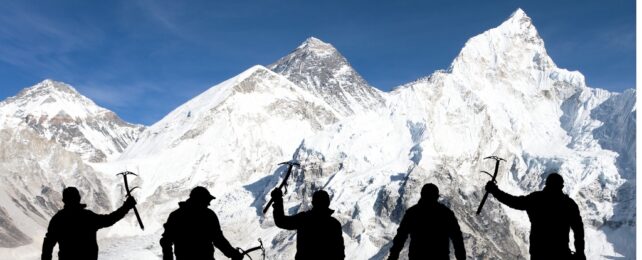Each year, hundreds of mountaineers camp at the South Col on Mount Everest's southern side in preparation for their attempt to reach the roof of the world.
While these adventure seekers may be taking home some well-deserved bragging rights, a new study shows they may also be leaving behind some tenacious microbes that seem capable of bunkering down to survive on the icy, desolate outcrops.
Despite the extreme conditions on Everest, researchers have been able to cultivate bacteria and fungi isolated from the mountain's sediments. These organisms, which are dormant for the most part, may have been transported from less extreme terrain to the snowless dip of the South Col by wind or by humans.
This study reveals the impact of tourists on the world's tallest peak, and may shed light on the limits to life on Earth and the potential for life on other worlds.
Located in the Mahalangur Himal range of the Himalayas, Mount Everest (Sagarmāthā in Nepali, or Chomolungma in Tibetan) stands taller than any other land surface on Earth, peaking at 29,031 feet (8,849 meters) above sea level.
Everest's high-altitude environments are among the most extreme on Earth. The South Col, where the research team led by microbial ecologist Nicholas Dragone from the University of Colorado Boulder (CU Boulder) collected soil samples, is around 7,900 feet above sea level.
So the researchers were surprised to discover that even microbes that have adapted to the warm and wet comfort of our noses and throats, such as Staphylococcus and Streptococcus, were able to lie dormant and survive the harsh, cold, dry conditions.
"There is a human signature frozen in the microbiome of Everest, even at that elevation," says senior author Steven Schmidt, a microbial ecologist at CU Boulder.
"If somebody even blew their nose or coughed, that's the kind of thing that might show up."
In addition to traditional culturing techniques involving the growth of bacteria on nutrient rich agar plates, the team sequenced snippets of genetic material in the soils to identify specific microbes. It is reportedly the highest elevation such samples have ever been examined in this manner.
Members of the team have looked at soil samples from places like the Andes as well as the Himalayas and Antarctica previously, but say this is the first time that samples taken at this elevation have shown definitive evidence of microorganisms that are linked to humans.
Higher concentrations of ultraviolet light, lower temperatures, and a lack of water all contribute to the death of microbes at high altitude, so only the most robust organisms can make it through a climate as hostile as this one.
Staphylococcus and Streptococcus bacteria are often found in soil, but the genetic sequences identified in this study were identical to those of common species that usually colonize our skin and mouths.
What's more, the samples were taken about 558 feet (170 meters) away from where snotty, sniffly, sneezing humans typically set up camp before taking on the summit challenge.
"We predict that if we sampled in the more human-utilized areas on the mountain we may find even more microbial evidence of human impact on the environment," the team write in their paper.
Most microbes, like those carried by humans to high altitudes, go dormant or die when exposed to conditions this extreme, but some organisms can grow during brief periods of water availability at lofty elevations, according to previous research.
Because air temperatures at South Col rarely lift above -10 °C (14 °F), it's unknown whether or not the scarce water from melting ice can support microbial growth, and it's no simple feat to test microbial growth at such extreme sites.
So, the soil on South Col and other high-elevation places may only collect and freeze the organisms that were put there by the air or by people. The better conditions in the lab may be what helped them to grow.
However, air temperatures in the Mount Everest region are rising at approximately 0.33 °C per decade, and in July 2022, the South Col recorded a record high of -1.4 °C. This warming trend could lead to organisms that are currently inactive becoming active in the future.
The authors say that the recently installed weather station at South Col might give more information as time goes on and more observations are made.
For now, researchers don't think this small addition of human germs to Everest will have a big impact on the environment. Nonetheless, this work has implications for the search for extraterrestrial life, for example, in the event that humans eventually reach Mars.
"We might find life on other planets and cold moons," says Schmidt.
"We'll have to be careful to make sure we're not contaminating them with our own."
The study has been published in the journal Arctic, Antarctic, and Alpine Research.
